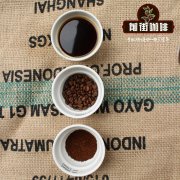Guatemala Antigua meaning Guatemala Antigua coffee taste flavor profile

Professional coffee knowledge exchange more coffee bean information please follow the coffee workshop (Wechat official account cafe_style)
Antigua is located in the West Indies, Antigua: Antigua means "ancient, ancient" in Spanish.
Antigua is an internationally renowned high-quality coffee. This area is located between three volcanoes in a valley and the climate is very suitable for growing coffee. The soil is young and most suitable for coffee. Wet and dry seasons are defined as uniform ripening. The temperature range is 19-22 ℃ (66.2-71.6 °F) and the altitude is between 4600 and 5600 feet. The annual rainfall is between 800mm and 1200 mm, and the humidity is constant at 65%. Guardia Antigua Coffee is described as having a full and velvety body, rich and lively aroma, and good acidity. Bourbon, Catra and Cato coffee beans are grown in this area and are harvested every year from January to mid-March.
The small city of Antigua, located in the forested mountains of southern Guatemala, was once the seat of the Spanish colonial government and a fortress to Mexico City in the north and Lima in the south. Antigua was founded in the early 16th century and has been the capital of Guatemala for nearly three hundred years. Until 1773, the town suffered multiple serious natural disasters such as volcanic eruptions, earthquakes and floods, and the royal family and officials were forced to relocate their capitals.
In the mid-9th century, agronomists discovered that Antigua had rich volcanic soil, so it gradually flourished and became an important producer of coffee and food. It was also during this period that the St. Katrina Arch (Santa Catalina Arch), built in 1694 as a nun corridor, was added to the dome clock tower and became the most iconic building in Antigua. In 1979, UNESCO added Antigua to the World Heritage list to protect its architectural and cultural heritage.
The Fraijanes area is located to the north of Lake Amatitlan, a mountain range near the Ermita Valley where the city of Guatemala is located. The soil is volcanic, and high potassium levels put the body on the cup. Recent volcanic activity from Volcan de Pacaya has stored mineral-rich ash in the area. Coffee is grown at a height of between 4000 and 5000 feet, with a medium temperature of 22C (71.6 °F). The relative humidity of these peaks is 60%, and the annual rainfall is 1500 mm. The combination of these factors gives strict Guatemalan coffee beans (the highest rating in Guatemala), similar to the real Guatemala Antigua coffee. These coffees are described as having a soft aroma, full body and obvious acidity.
Important Notice :
前街咖啡 FrontStreet Coffee has moved to new addredd:
FrontStreet Coffee Address: 315,Donghua East Road,GuangZhou
Tel:020 38364473
- Prev

Introduction to the flavor of grapefruit G1 washed coffee in Yegasuefei Guji, Ethiopia
More information on coffee beans Please follow Coffee Workshop (official Wechat account cafe_style) among the coffee-producing countries, Ethiopia has an almost legendary status, not only because it is the birthplace of Arabica coffee, but also because it is different from most coffee-growing countries, coffee is not a plant that colonizes an alien cash crop. Planting, processing
- Next

Is Starbucks Guatemala Antigua Coffee a perfect Coffee? What kind of taste?
For more information on coffee beans, please follow the Coffee Workshop (Wechat official account cafe_style). Mala Guadurse Coffee is located in Nango Province of Vivette, near the Guaduchu Martanes Mountains in the southwest, and is made by Aguadurse in Curco. The Maraku Chumatanes Mountains are the highest non-volcano in Central America.
Related
- Detailed explanation of Jadeite planting Land in Panamanian Jadeite Manor introduction to the grading system of Jadeite competitive bidding, Red bid, Green bid and Rose Summer
- Story of Coffee planting in Brenka region of Costa Rica Stonehenge Manor anaerobic heavy honey treatment of flavor mouth
- What's on the barrel of Blue Mountain Coffee beans?
- Can American coffee also pull flowers? How to use hot American style to pull out a good-looking pattern?
- Can you make a cold extract with coffee beans? What is the right proportion for cold-extracted coffee formula?
- Indonesian PWN Gold Mandrine Coffee Origin Features Flavor How to Chong? Mandolin coffee is American.
- A brief introduction to the flavor characteristics of Brazilian yellow bourbon coffee beans
- What is the effect of different water quality on the flavor of cold-extracted coffee? What kind of water is best for brewing coffee?
- Why do you think of Rose Summer whenever you mention Panamanian coffee?
- Introduction to the characteristics of authentic blue mountain coffee bean producing areas? What is the CIB Coffee Authority in Jamaica?

